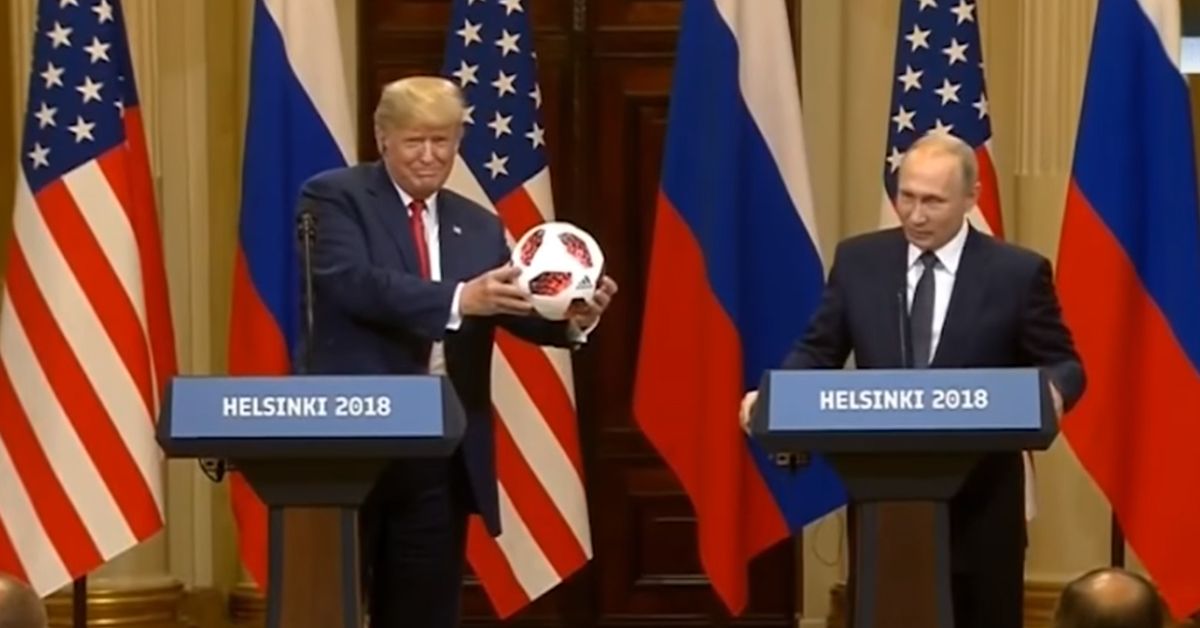On 16 July 2018, U.S. president Donald Trump and Russian president Vladimir Putin held a controversial summit meeting in Helsinki, Finland. During an equally controversial press conference following one meeting between the two men, Putin (whose country had just hosted the FIFA World Cup) presented Trump with a 2018 FIFA World Cup “Official Matchball” as a gift, Many, including U.S. Senator Lindsey Graham, warned Trump to make sure the ball was not “bugged” with an embedded listening device:
Finally, if it were me, I’d check the soccer ball for listening devices and never allow it in the White House.
— Lindsey Graham (@LindseyGrahamSC) July 16, 2018
The notion that the gift from Putin was bugged gained more attention after Bloomberg commented on the probable existence of a small Near Field Communication (NFC) chip implanted in the ball. “Putin gave Trump a soccer ball that may have a transmitter chip,” CNN reported. “Yep, That Soccer Ball That Vladimir Putin Gave to Trump Had a Transmitter Chip,” read a headline at The Root. Missing from these and similar headlines was the fact that every single Adidas ball of this model incorporates an NFC chip that provides customers with “exclusive” content.
By tapping a mobile phone to these NFC-chipped balls, the Adidas website explains, users will be directed to the “Telstar 18 experience”:
The experience offers different functionalities like exclusive information about the product, adidas football content, special competitions and challenges, etc. Features will be updated so… keep tapping!
NFC technology allows for short-range communication between two devices and is commonly used in mobile payment systems. These systems involve a powered device (generally a mobile phone) that generates a radio field which, in turn, interacts with the chip (if they are physically close) in a way that allows the transfer of data. “Compared to other wireless protocols like Wi-Fi or Bluetooth, NFC is exceedingly slow,” explained a 2011 Popular Science article. Among NFC's benefits, however, are that it requires very little power to operate.
Adidas assures their customers that it is “not possible” to “rewrite the coded parameters of the chip,” but while this may be true, a different NFC chip could be intentionally manufactured to direct a phone, for example, to download malicious content. In 2015, former US Navy petty officer Seth Wahle inserted an NFC chip into his hand “that ping[ed] Android phones, asking them to open a link” which could then, theoretically, be used to further exploit the phone.
Linus Neumann, a spokesman for a Hamburg-based hacker collective known as the Chaos Computer Club, told Bloomberg that using the "bugged soccer ball" method to spy on President Trump would likely not be successful. “Trump would have to ignore multiple security warnings and intentionally install malware on his device,” Neumann said. Scott Schober, a cybersecurity expert, told CNN that the NFC technology would be an unlikely choice for espionage: "This is the kind of technology used for mobile payment with smartphones, and it involves bringing the two devices very close, in this case typically within a couple of centimeters. If anyone had any nefarious motives, they probably picked the wrong technology."
RT, a Russian state-funded international television network, mocked claims that the inclusion of this chip could be considered an attempt to spy on the President:
While some in the US thought they had uncovered an ingenious and nefarious ploy by the Kremlin to listen in on Trump’s conversations — seemingly oblivious to the president's prolific and voluminous output on Twitter — the tech is simply a feature of any old ball you can pick up in your local store.
Benign as this specific gift might have been, Russia has a history of bugging U.S. governmental offices with “gifts” that contain spy technology. In August 1945, W. Averell Harriman, the United States Ambassador to the Soviet Union, famously received a carved wooden plaque of the Great Seal of the United States as a gift from the “Young Pioneer organization of the Soviet Union.” Years later, in 1952, U.S. and British officials discovered a listening device contained inside the seal. Similar to RFID and NFC devices, this system was passive, operating only when the Soviets beamed a specific radio frequency to the area.
Now, the U.S. government regularly screens for covert listening devices in any gifts officials receive from foreign governments. In a statement to CNN, the Secret Service said that "all gifts given to the President are subject to thorough security screening. The Secret Service does not comment specifically nor in general about the means and methods of our protective responsibilities."
